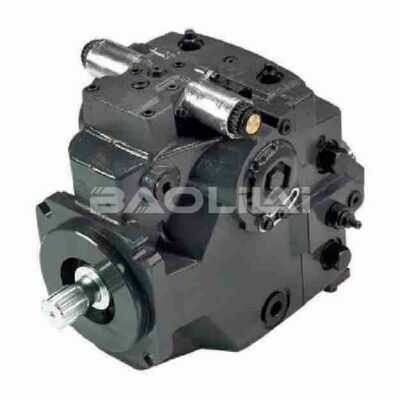When the flow rate of the hydraulic pump is very large, is there any damping in the pipeline
When the flow rate of the hydraulic pump is large, a damping effect will occur in the hydraulic pipeline. These damping effects are primarily due to fluid properties, piping design, and any components in the hydraulic system. Here are some factors that can affect damping in high-flow hydraulic systems:
1. Fluid viscosity: The viscosity of hydraulic oil creates internal friction within the fluid as it flows through the pipe. This friction can act as a damping factor, especially at high flow rates.
2. Pipe length and diameter: The length and diameter of the hydraulic pipe will affect damping. Longer and narrower pipes introduce more friction and turbulence into the system, inhibiting flow.
3. Pipe roughness: The roughness of the inner surface of the pipe affects the flow characteristics and introduces damping. Smoother pipes generally have less damping due to reduced friction.
4. Pipeline components: Valves, fittings, and other components in hydraulic pipelines can create obstructions and turbulence that can cause damping. Proper component selection and design can minimize these effects.
5. Pressure drop: High flow rates can cause significant pressure drops in pipes and components. These pressure drops can affect system performance and introduce damping.
6. System design: The overall design of the hydraulic system, including component placement and material selection, affects damping. Proper design helps minimize damping effects.
H1-P-250-R-A-A-A5-C1-B-D8-C-G2-H3-L-45-L-45-W-P-24-PN-NNN-NNN H1P250RAAA5C1BD8CG2H3L45L45WP24PNNNNNNN
H1-P-250-R-A-A-A5-C1-B-D6-C-G2-NN-L-42-L-42-W-L-24-PN-NNN-NNN H1P250RAAA5C1BD6CG2NNL42L42WL24PNNNNNNN
H1-P-250-R-A-A-A5-C1-B-D6-C-G2-NN-L-33-L-33-W-L-24-PN-NNN-NNN H1P250RAAA5C1BD6CG2NNL33L33WL24PNNNNNNN
H1-P-250-R-A-A-A5-C1-B-D6-C-F8-E2-L-42-L-42-W-L-24-PN-NNN-NNN H1P250RAAA5C1BD6CF8E2L42L42WL24PNNNNNNN
H1-P-250-R-A-A-A4-C3-N-D6-C-G2-H1-L-45-L-45-W-L-24-PN-NNN-NNN H1P250RAAA4C3ND6CG2H1L45L45WL24PNNNNNNN
H1-P-250-R-A-A-A4-C2-N-D6-C-G2-H6-L-45-L-45-W-L-30-PN-NNN-NNN H1P250RAAA4C2ND6CG2H6L45L45WL30PNNNNNNN
H1-P-250-R-A-A-A4-C2-N-D6-C-G2-H3-L-45-L-45-W-L-24-PN-NNN-NNN H1P250RAAA4C2ND6CG2H3L45L45WL24PNNNNNNN
H1-P-250-R-A-A-A3-C3-N-D8-C-G2-H6-K-42-K-42-R-P-34-PN-NNN-NNN H1P250RAAA3C3ND8CG2H6K42K42RP34PNNNNNNN
H1-P-250-R-A-A-A3-C3-N-D8-C-G2-H3-L-45-L-45-R-P-24-PN-NNN-NNN H1P250RAAA3C3ND8CG2H3L45L45RP24PNNNNNNN
H1-P-250-R-A-A-A3-C3-N-D8-C-G2-E2-K-42-K-42-R-P-34-PN-NNN-NNN H1P250RAAA3C3ND8CG2E2K42K42RP34PNNNNNNN
H1-P-250-R-A-A-A3-C3-N-D8-C-F8-H6-K-42-K-42-R-P-34-PN-NNN-NNN H1P250RAAA3C3ND8CF8H6K42K42RP34PNNNNNNN
H1-P-250-R-A-A-A3-C3-N-D8-C-F8-H3-K-42-K-42-R-P-34-PN-NNN-NNN H1P250RAAA3C3ND8CF8H3K42K42RP34PNNNNNNN
H1-P-250-R-A-A-A3-C2-N-D8-C-G3-NN-K-25-K-25-W-P-20-PN-NNN-NNN H1P250RAAA3C2ND8CG3NNK25K25WP20PNNNNNNN
H1-P-250-R-A-A-A3-C2-N-D8-C-G2-H4-L-42-L-42-W-P-24-PN-NNN-NNN H1P250RAAA3C2ND8CG2H4L42L42WP24PNNNNNNN
H1-P-250-R-A-A-A3-C2-N-D8-C-G2-H3-L-42-L-42-R-P-28-PN-NNN-NNN H1P250RAAA3C2ND8CG2H3L42L42RP28PNNNNNNN
H1-P-250-R-A-A-A3-C2-N-D8-C-F8-E1-L-42-L-42-W-P-24-PN-NNN-NNN H1P250RAAA3C2ND8CF8E1L42L42WP24PNNNNNNN
H1-P-250-R-A-A-A3-C2-B-D8-C-G2-NN-L-25-L-25-W-P-24-PN-NNN-NNN H1P250RAAA3C2BD8CG2NNL25L25WP24PNNNNNNN
H1-P-250-R-A-A-A3-C1-N-D8-C-F8-E2-L-42-L-42-W-P-24-PN-NNN-NNN H1P250RAAA3C1ND8CF8E2L42L42WP24PNNNNNNN
H1-P-250-R-A-A-A3-C1-N-D6-C-G3-E1-L-35-L-35-W-L-34-PN-NNN-NNN H1P250RAAA3C1ND6CG3E1L35L35WL34PNNNNNNN
H1-P-250-R-A-A-A3-C1-N-D6-C-F8-E1-L-35-L-35-W-L-34-PN-NNN-NNN H1P250RAAA3C1ND6CF8E1L35L35WL34PNNNNNNN
To further reduce or manage damping in high-flow hydraulic systems, you may consider the following strategies:
1. Fluid Selection: Selecting a hydraulic fluid with the proper viscosity helps reduce internal friction, thereby reducing the damping effect. Proper fluid maintenance and filtration are also critical to ensuring consistent fluid characteristics.
2. Pipe sizing: Properly sizing hydraulic pipes based on required flow and pressure helps minimize pressure drop and reduce damping. Using larger diameter pipes reduces fluid velocity and turbulence.
3. Smooth pipes: Specifying pipes with smooth interior surfaces can reduce friction and turbulence. Proper surface finish and material selection are critical.

4. Component selection: Careful selection of components such as valves and accessories that minimize resistance and turbulence can help minimize damping. High-quality, low-loss components are often the first choice for high-flow hydraulic systems.
5. Optimize system layout: The layout of the hydraulic system, including the arrangement of components, should be optimized to minimize pressure drop and reduce damping.
6. Regulation and control: Implementing effective control strategies and feedback mechanisms can help compensate for damping effects and improve system performance. Proportional Integral Derivative (PID) control or other advanced control algorithms can be used for this purpose.
7. Balance flow: In situations where a single pump serves multiple branches or actuators, balancing the flow between these branches helps reduce pressure fluctuations and damping effects.
8. System Testing and Simulation: The hydraulic system is thoroughly tested and simulated to identify and resolve any damping issues. This may involve using software tools for traffic modeling and analysis.
H1-P-250-R-A-A-A3-C1-B-D6-C-G3-NN-K-30-K-30-R-L-20-PN-NNN-NNN H1P250RAAA3C1BD6CG3NNK30K30RL20PNNNNNNN
H1-P-250-R-A-A-A2-C2-N-D8-C-G2-H6-L-42-L-42-W-P-24-PN-NNN-NNN H1P250RAAA2C2ND8CG2H6L42L42WP24PNNNNNNN
H1-P-250-R-A-A-A2-C2-N-D8-C-G2-H2-L-42-L-42-W-P-24-PN-NNN-NNN H1P250RAAA2C2ND8CG2H2L42L42WP24PNNNNNNN
H1-P-250-R-A-A-A2-C2-N-D8-C-G2-E2-L-42-L-42-W-P-24-PN-NNN-NNN H1P250RAAA2C2ND8CG2E2L42L42WP24PNNNNNNN
H1-P-250-R-A-A-A2-C2-N-D6-C-G2-NN-L-45-L-45-R-L-28-PN-NNN-NNN H1P250RAAA2C2ND6CG2NNL45L45RL28PNNNNNNN
H1-P-250-L-A-A-M2-C2-B-D8-C-F8-H4-L-38-L-38-W-P-24-H1-NNN-M00 H1P250LAAM2C2BD8CF8H4L38L38WP24H1NNNM00
H1-P-250-L-A-A-M2-C2-B-D8-C-F8-H3-L-38-L-38-W-P-24-H1-NNN-M00 H1P250LAAM2C2BD8CF8H3L38L38WP24H1NNNM00
H1-P-250-L-A-A-E8-C2-N-D6-C-G2-H6-L-38-L-20-R-L-24-PN-NNN-NNN H1P250LAAE8C2ND6CG2H6L38L20RL24PNNNNNNN
H1-P-250-L-A-A-A5-C2-N-D8-E-G3-H6-L-41-L-41-W-P-24-P4-NNN-NNN H1P250LAAA5C2ND8EG3H6L41L41WP24P4NNNNNN
H1-P-250-L-A-A-A5-C2-N-D8-E-G2-H3-L-42-L-42-R-P-28-P4-NNN-NNN H1P250LAAA5C2ND8EG2H3L42L42RP28P4NNNNNN
H1-P-250-L-A-A-A5-C2-N-D8-E-G2-H2-L-42-L-42-R-P-28-P4-NNN-NNN H1P250LAAA5C2ND8EG2H2L42L42RP28P4NNNNNN
H1-P-250-L-A-A-A5-C2-N-D8-C-G3-NN-L-42-L-42-N-E-24-PN-NNN-NNN H1P250LAAA5C2ND8CG3NNL42L42NE24PNNNNNNN
H1-P-250-L-A-A-A5-C2-N-D8-C-G3-H6-L-35-L-35-W-P-24-PN-NNN-NNN H1P250LAAA5C2ND8CG3H6L35L35WP24PNNNNNNN
H1-P-250-L-A-A-A5-C2-N-D8-C-G2-NN-L-35-L-35-R-P-24-PN-NNN-NNN H1P250LAAA5C2ND8CG2NNL35L35RP24PNNNNNNN
H1-P-250-L-A-A-A5-C2-N-D8-C-G2-H5-L-35-L-35-R-P-24-PN-NNN-NNN H1P250LAAA5C2ND8CG2H5L35L35RP24PNNNNNNN
H1-P-250-L-A-A-A5-C2-N-D8-C-G2-H4-L-35-L-35-R-P-24-PN-NNN-NNN H1P250LAAA5C2ND8CG2H4L35L35RP24PNNNNNNN
H1-P-250-L-A-A-A5-C2-N-D6-C-G3-H3-L-25-L-25-W-L-24-PN-NNN-NNN H1P250LAAA5C2ND6CG3H3L25L25WL24PNNNNNNN
H1-P-250-L-A-A-A5-C2-N-D6-C-G2-NN-L-23-L-23-R-L-20-PN-NNN-NNN H1P250LAAA5C2ND6CG2NNL23L23RL20PNNNNNNN
H1-P-250-L-A-A-A5-C2-B-D8-C-G3-H6-L-33-L-33-W-P-34-PN-NNN-NNN H1P250LAAA5C2BD8CG3H6L33L33WP34PNNNNNNN
H1-P-250-L-A-A-A5-C2-B-D8-C-G2-NN-L-42-L-42-R-P-24-PN-NNN-NNN H1P250LAAA5C2BD8CG2NNL42L42RP24PNNNNNNN
9. Monitoring and maintenance: Regular monitoring of system performance and component maintenance can help detect and mitigate damping problems early and ensure long-term efficient operation of the system.
10. Fluid temperature control: Controlling the temperature of the hydraulic oil also affects damping. Extreme temperature changes can affect the viscosity of the fluid, causing changes in damping characteristics. Maintaining the fluid at a constant temperature using a cooling or heating system can help stabilize the system.
11. Pulsation Damper: In situations where pressure pulsations or hydraulic shock waves cause damping problems, the use of a pulsation damper (accumulator) may be beneficial. These devices absorb and dampen pressure fluctuations, allowing for smoother flow.
12. Noise Control: Damping may sometimes be related to the noise generated within the hydraulic system. Addressing noise issues through acoustic design and materials can indirectly help reduce damping issues.
13. Education and training: Ensure that personnel operating and maintaining hydraulic systems are well trained. Proper knowledge and practice can help identify and correct damping problems promptly.
14. Periodic system evaluation: Periodically evaluate the performance of the hydraulic system to detect any issues related to damping, such as flow fluctuations or pressure drops. This proactive approach can help prevent system inefficiencies.
15. Consult an Expert: If you are experiencing severe damping problems in a high-flow hydraulic system, consider consulting a hydraulic engineering expert who can provide guidance and expertise in resolving the problem.
Damping is a complex issue in hydraulic systems that often requires a combination of strategies and a deep understanding of the specific system and application to effectively solve the problem. Additionally, it is important to maintain a balance between reducing damping and achieving the desired system stability and response characteristics. Sometimes, a certain degree of damping is required to prevent system oscillation and damage, especially in systems with rapid changes in flow or changes in high pressure.
This article is published by the official website of Baolilai Hydraulics, please contact the author and indicate the source for reprinting:https://www.baolilai-pump.cn/news/1139.html






